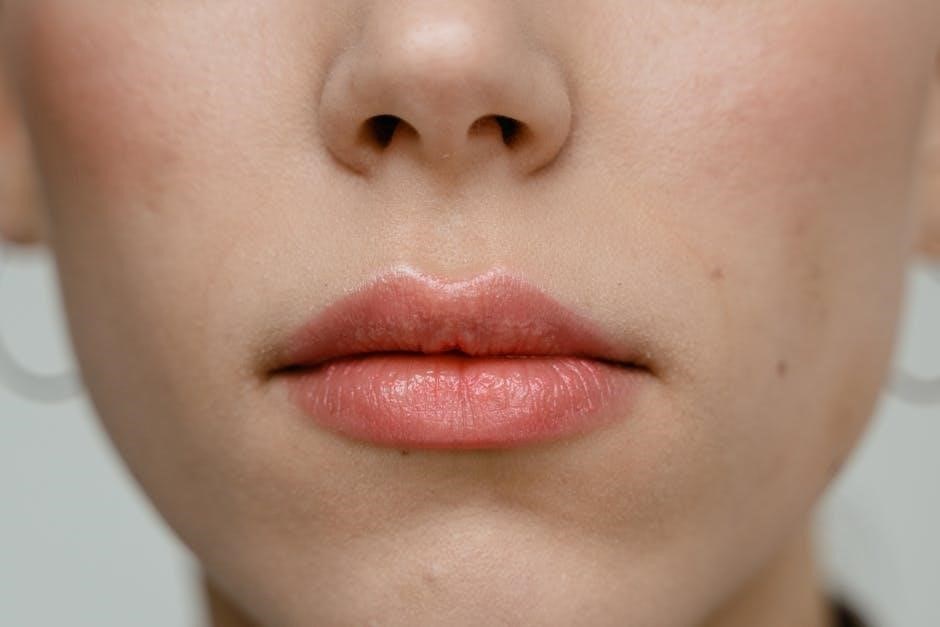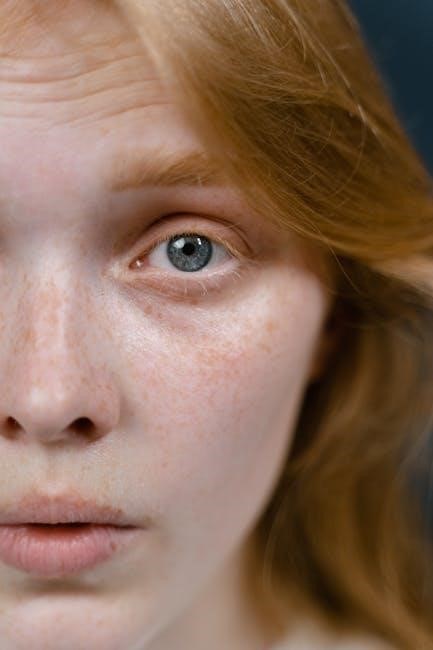The nose is a vital organ essential for breathing, filtering air, and enabling the sense of smell. Its unique structure and cultural significance make it a focal point of both function and identity.
Overview of the Nose and Its Importance
The nose is a critical organ responsible for breathing, filtering, and humidifying the air we inhale. It plays a vital role in maintaining respiratory health by trapping dust, allergens, and bacteria. The nose also houses the olfactory system, enabling the sense of smell, which influences taste and emotional well-being. Its structure and function are essential for overall health, while its aesthetic appeal contributes to facial identity. Cultural and racial variations in nose shape and size highlight its unique significance in human diversity. Proper care and hygiene are crucial to prevent infections and maintain its functionality.
Historical and Cultural Significance of the Nose
The nose has held significant cultural and historical value across civilizations. In literature, it often symbolizes identity, as seen in Gogol’s The Nose. Artistically, it has been a focal point in sculptures and portraits, representing individuality. Culturally, nose shapes and sizes have been associated with beauty standards and ethnic identity. For example, ancient civilizations like Egyptians and Greeks idealized specific nasal forms. Additionally, the nose has been a symbol in rituals, such as nose piercing in some cultures, signifying marital status or spiritual practices. Historically, it has also been a marker of social status, with alterations documented in ancient texts.

Anatomy of the Nose
The nose consists of an external structure and internal nasal cavity. The nasal septum divides the cavity, influencing both aesthetics and function. Ethnic variations exist in nose width.
External Structure of the Nose
The external nose is a visible, protruding structure with aesthetic and functional significance. It varies in shape, size, and width among individuals and ethnic groups. Studies show differences in nasal width, with averages of 34.0 mm in whites, 38.7 mm in Asians, and 42.5 mm in blacks. The nasal tip and dorsum contribute to its appearance. The external structure is also influenced by the nasal septum, which, when dislocated, can affect both form and function. Proper illumination and elevation of the nasal tip are essential for examining the nasal cavity and septum during medical assessments.
Internal Anatomy: Nasal Cavity and Septum
The nasal cavity is a vital airway lined with mucous membranes and cilia, essential for filtering, humidifying, and warming inhaled air. The nasal septum, a cartilaginous and bony structure, divides the cavity into two symmetrical passages. A deviated septum can impair airflow and increase the risk of respiratory issues. The septum’s shape and position significantly influence nasal aesthetics and function. Proper nasal irrigation with saline solutions helps maintain mucosal health and clear blockages, ensuring optimal respiratory function and olfactory sensitivity.

Functions of the Nose
The nose performs critical roles in air filtration, humidification, and warming, while also housing the olfactory system, enabling the detection of odors essential for taste and environmental awareness.
Role in Breathing and Air Filtration
The nose is essential for breathing, filtering, and conditioning the air we inhale. The nostrils capture air, which then passes through nasal hairs that trap dust, pollen, and other particles. The mucous membrane lining the nasal cavity secretes mucus, further trapping pathogens and allergens. This filtration prevents harmful substances from reaching the lungs. Additionally, the nose warms and humidifies the air, ensuring it reaches the lungs in optimal condition. This dual function of air filtration and conditioning is crucial for maintaining respiratory health and overall well-being.
Sense of Smell and Olfactory System
The nose plays a critical role in the sense of smell through its olfactory system. Olfactory receptors in the nasal cavity detect odor molecules, which are then processed by the brain. The mucus layer in the nose traps these molecules, allowing the receptors to identify specific scents. This system enables us to distinguish between thousands of different smells, enhancing our ability to enjoy food, detect danger, and experience emotions tied to memory. The connection between the nose and brain highlights the importance of smell in our daily lives and overall sensory perception.

Common Nasal Health Issues
Nasal health issues often involve congestion, sinusitis, and infections, which can cause discomfort, breathing difficulties, and impact overall well-being.

Nasal Congestion and Allergies
Nasal congestion occurs when nasal passages become blocked, often due to inflammation of the nasal mucosa. Allergies are a common cause, triggering swelling and excessive mucus production. Symptoms include stuffiness, difficulty breathing, and sinus pressure. Remedies such as saline sprays and humidifiers can help alleviate symptoms. Nasal steroids are effective for long-term relief but should be used cautiously. If symptoms persist beyond a week, consulting a healthcare professional is advisable to rule out infections or other underlying conditions.
Sinusitis and Respiratory Infections
Sinusitis is an inflammation of the paranasal sinuses, often caused by viral or bacterial infections. Symptoms include facial pain, congestion, and fever. Respiratory infections, such as the common cold or flu, frequently lead to sinusitis. Treatment options include steam inhalation, over-the-counter decongestants, and, in severe cases, antibiotics. Chronic sinusitis may require prolonged medical intervention. Maintaining nasal hygiene and using saline solutions can help prevent complications. Early diagnosis is crucial to avoid prolonged discomfort and potential spread of infection.

Nose Care and Hygiene
Regular nasal hygiene is crucial for maintaining respiratory health. Use saline solutions for irrigation and humidifiers to prevent dryness, promoting clear breathing and overall well-being.
Saline Solutions for Nasal Irrigation
Saline solutions are a safe and effective method for nasal irrigation, helping to clear mucus and debris. They can be used to relieve congestion and allergies. Regular use promotes healthy nasal passages by moisturizing the mucosa and preventing dryness. Saline sprays or neti pots are common tools for this practice. It is important to use sterile or filtered water to avoid infections. Daily irrigation can significantly improve breathing and reduce sinus pressure, making it a popular home remedy for maintaining nasal health and hygiene. Proper technique ensures safety and effectiveness.
Humidifiers and Their Role in Nasal Health
Humidifiers add moisture to the air, preventing dryness in the nasal passages and promoting better breathing. They are particularly beneficial in dry climates or during winter when heating systems dry out the air. By maintaining optimal humidity levels, humidifiers help reduce nasal congestion, sinus pressure, and irritation caused by allergies or colds. Regular use can improve nasal health by keeping the mucosa hydrated and functioning properly. This makes humidifiers a valuable tool for maintaining nasal hygiene and relieving respiratory discomfort, especially for those prone to sinus issues or seasonal allergies.

Surgical Procedures Related to the Nose
Surgical procedures like septoplasty and rhinoplasty address nasal septum deviations and aesthetic or functional concerns. These surgeries improve breathing, correct structural issues, and enhance nasal appearance, offering both functional and cosmetic benefits.
Septoplasty: Correction of the Nasal Septum
Septoplasty is a surgical procedure to correct a deviated or malformed nasal septum, improving breathing and addressing structural issues. The septum, a cartilage and bone dividing the nasal cavity, when misaligned, can cause congestion, sinusitis, or nasal discharge. During surgery, the septum is straightened or repositioned, often under general anesthesia. Recovery involves swelling, bruising, and nasal packing for a few days. This procedure is frequently combined with rhinoplasty for aesthetic adjustments. Septoplasty aims to restore normal nasal function, enhance airflow, and alleviate chronic respiratory discomfort, offering significant long-term benefits for patients with septal deviations.
Rhinoplasty: Aesthetic and Functional Surgery
Rhinoplasty, often referred to as a “nose job,” is a surgical procedure designed to reshape or repair the nose for aesthetic or functional reasons. It can address concerns such as asymmetry,size, or structural defects, while also improving breathing issues caused by a deviated septum. The surgery involves modifying the cartilage, bone, or skin of the nose, tailored to individual preferences and facial proportions. Performed under general or local anesthesia, rhinoplasty typically requires several weeks of recovery, with swelling subsiding gradually. It enhances both the appearance and function of the nose, offering transformative results for patients seeking to refine their facial features or alleviate respiratory difficulties.

Nasal Development and Aging
The nose develops significantly during childhood and adolescence, reaching maturity in early adulthood. Aging leads to gradual changes, including cartilage weakening and loss of skin elasticity.
Changes in the Nose During Childhood and Adolescence
The nose undergoes significant development during childhood and adolescence, with growth spurts influenced by hormonal changes. During puberty, the nose increases in length and width, reaching its adult proportions. The nasal septum also matures, though deviations may occur, potentially affecting breathing. Adolescents often experience changes in nasal shape and proportion, which can impact self-perception. These developmental phases are crucial for both functional and aesthetic aspects of the nose, laying the foundation for its role in respiratory and olfactory functions throughout life. Monitoring these changes is essential for addressing any emerging issues, such as allergies or sinusitis.
Nasal Health in the Elderly
As people age, nasal health becomes more vulnerable due to thinning mucosa, reduced mucus production, and decreased immune function. Elderly individuals often experience nasal congestion, dryness, and sinusitis. Respiratory infections are more common, and symptoms like difficulty breathing or loss of smell may persist. Humidifiers can help maintain moisture, while saline irrigation aids in clearing mucus. Regular medical check-ups are crucial to manage chronic conditions and prevent complications. Ensuring proper nasal care is essential for maintaining quality of life and overall respiratory health in older adults.

Cultural and Media Representations
The nose has been a symbol in literature, art, and media, often representing identity, vanity, or cultural uniqueness. Its imagery spans from comedic exaggeration to profound symbolism.
The Nose in Literature and Art
The nose has been a fascinating subject in literature and art, often symbolizing identity, vanity, or cultural uniqueness; In Nikolai Gogol’s The Nose, the protagonist’s detached nose embodies absurdity and societal critique. Similarly, Dmitri Shostakovich’s opera adaptation highlights the nose’s transformation into a symbol of power. In art, the nose has been exaggerated or abstracted by artists like Picasso, reflecting its cultural and aesthetic significance. These depictions underscore the nose’s dual role as both a biological feature and a metaphor for human identity and societal norms across creative mediums.
The nose is a vital organ with essential roles in breathing, smelling, and overall health. Advances in medical care and hygiene practices continue to enhance nasal well-being and function.
The nose plays a crucial role in breathing, air filtration, and the sense of smell. Its anatomy includes the external structure and internal nasal cavity, which house the septum. Common health issues like nasal congestion, allergies, and sinusitis affect its function. Proper care, such as using saline solutions and humidifiers, can maintain nasal health. Surgical procedures like septoplasty and rhinoplasty address structural issues. Understanding nasal development, aging, and cultural representations provides a comprehensive view of its significance. This summary highlights the nose’s importance in health, function, and human identity.
Future Directions in Nasal Health and Research
Advancements in nasal health and research focus on innovative treatments for chronic conditions like sinusitis and allergies. Emerging technologies, such as stem cell therapy and gene editing, aim to repair damaged nasal tissues. Personalized medicine tailored to individual genetic profiles may revolutionize treatment outcomes. Additionally, nanotechnology could enhance drug delivery systems for nasal medications. Research into the microbiome’s role in nasal health is expanding, offering insights into probiotic therapies. These developments, combined with improved surgical techniques, promise better quality of life for individuals with nasal disorders, highlighting the nose’s significance in overall health and well-being.